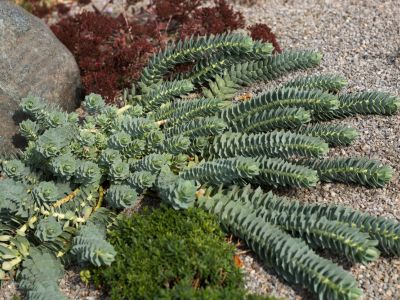Succulent Rock Garden Design
Rockeries are an excellent place to show off a succulent collection. Depending upon where you live, there are many sizes and growth forms from which to choose. Rock gardens afford dimension for the eye while also providing interesting textures and color. They are easy to upkeep if properly prepared and a long-lasting feature of interest in the garden. Before you install succulents in a rock garden, consider the size, shape, and height of your rockery. The first steps to building a succulent rock garden are to clear the area, weed, and amend the soil so it is well draining. Adding some gritty material like sand, perlite, or volcanic rock will enhance percolation. There are different ways of designing the garden. You may choose to move in very large rocks to plant around, fill in entirely with rock and tuck succulents in between cracks, or plant first and then gently spread rocks amongst the plants. The easiest is probably the first and it can be combined with rocks of different sizes.
Installing Larger Succulents in a Rock Garden
As you design a rock garden with succulents, consider focal point plants. These are often best installed prior to filling the area with smaller rocks as they will need deeper holes and a larger growing space. A ponytail palm is a fun plant that can grow as big as a small bush. Aloes and agaves come in many sizes and will produce offsets to increase the number of plants. Some pachypodiums will get almost the size of a small tree and larger cacti like organ pipe cactus will produce stunning architectural effect. For moderate sized plants, use euphorbias, dasylirion, and other succulents that will add texture and color.
Groundcover and Small Succulents for Rock Gardens
Selecting specimens for a rock garden with succulents is the fun part. Make sure your plants will thrive in your gardening zone and appreciate the exposure to light, wind, and other factors that they will be receiving. Using groundcover plants as foils for larger cacti or succulent bushes will help the area fill in. Plants like hens and chicks are classic examples of filling material. They will spread gradually, giving the area a natural look. Also choose:
SedumAeoniumRosulariaCrassulaPortulacariaEcheveriaSempervivumIce PlantDudleya
